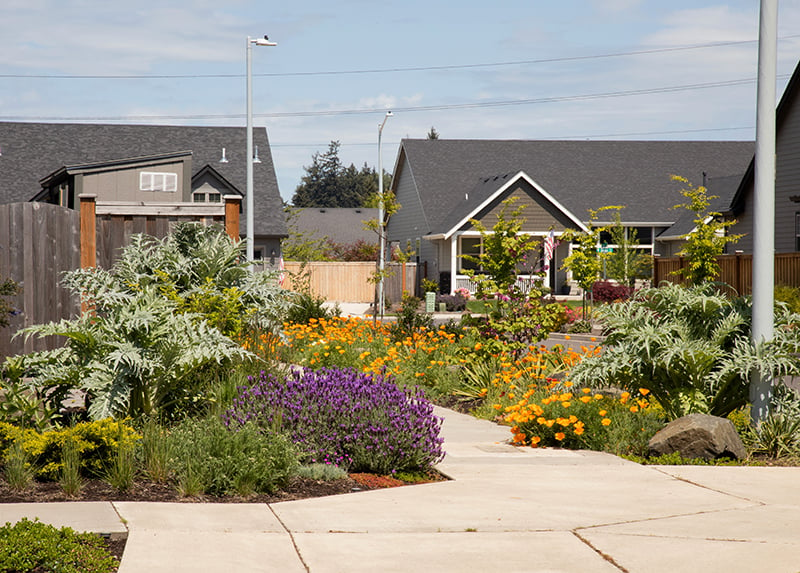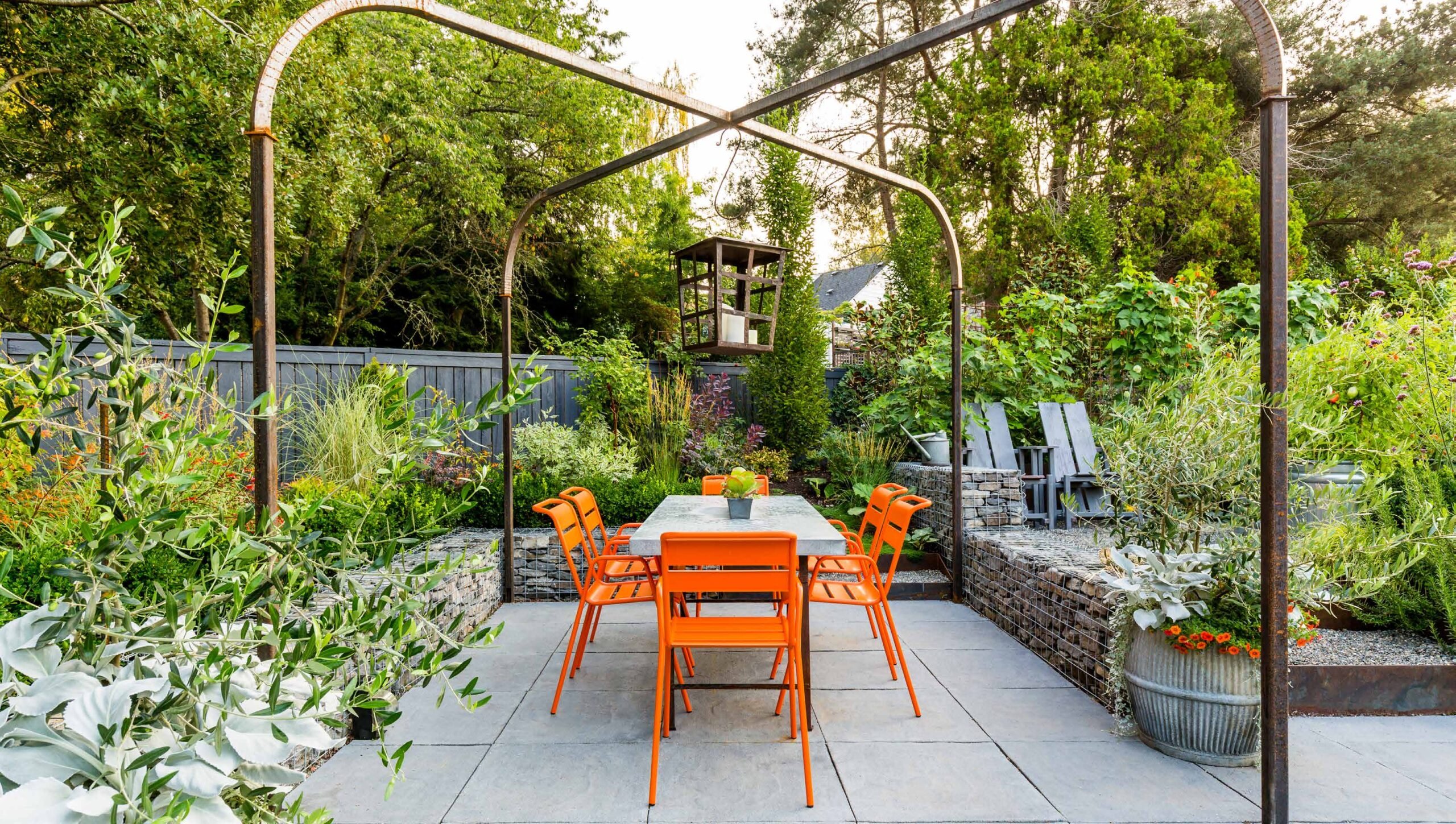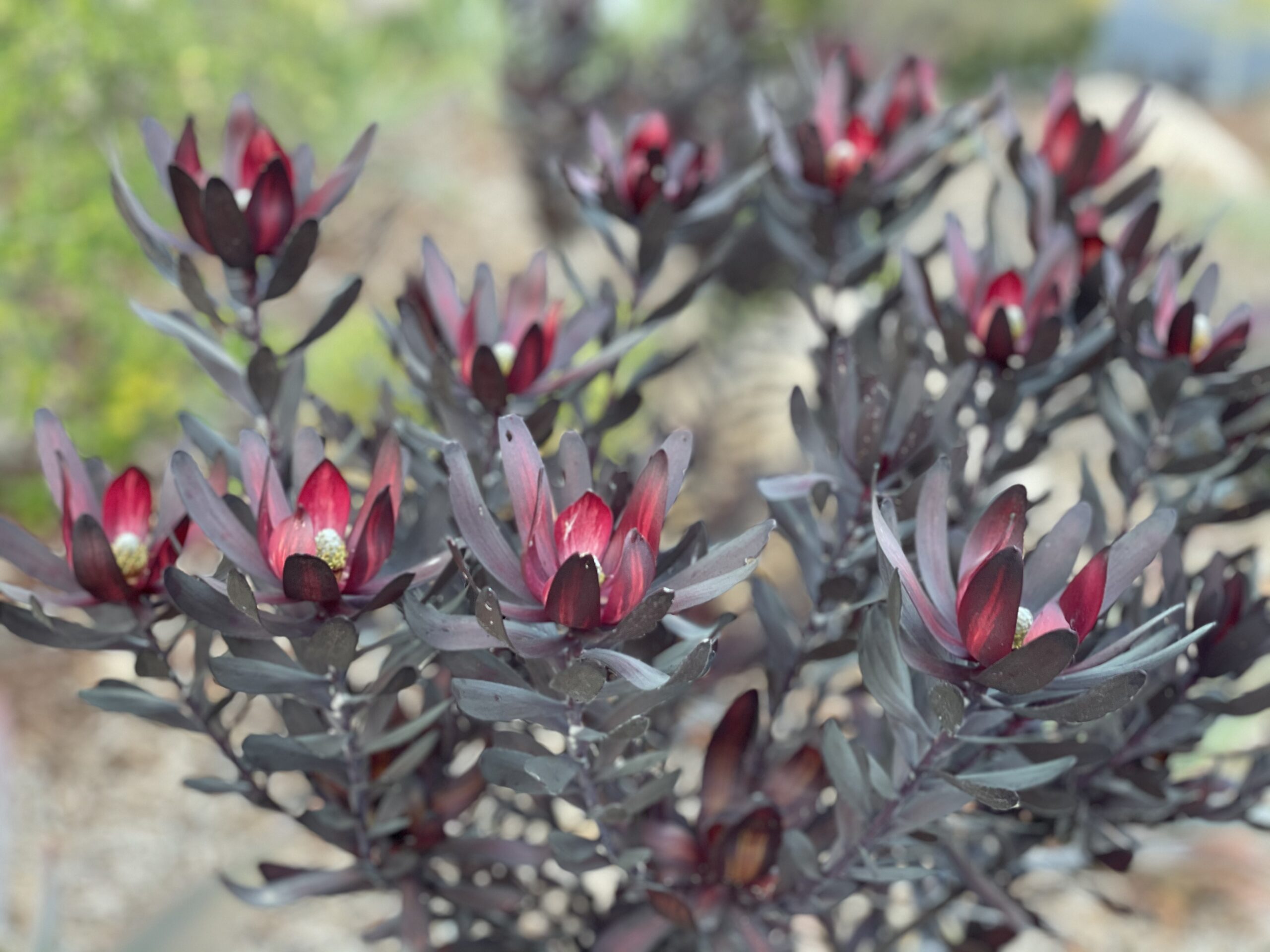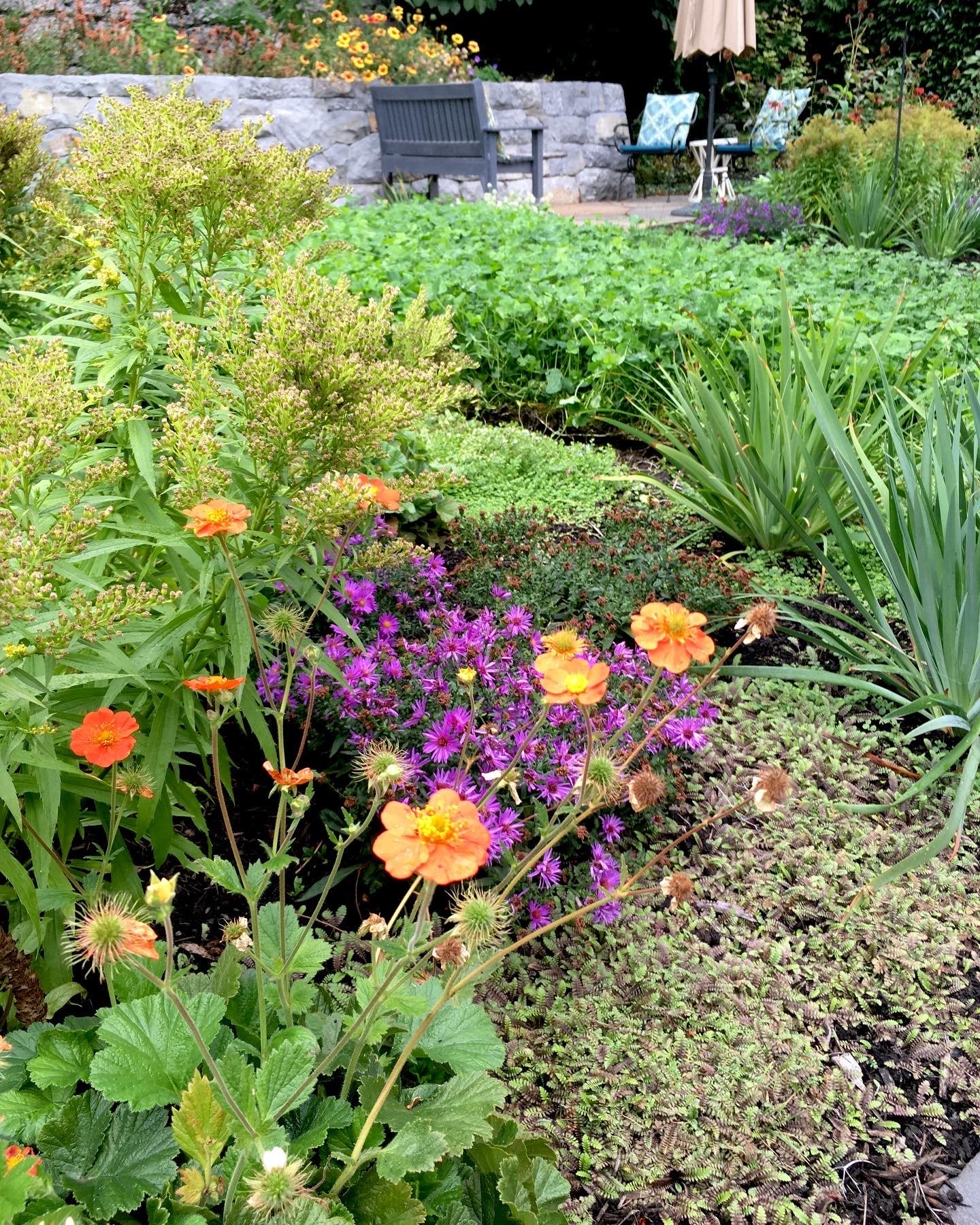
The Beauty of Organized Chaos

Contributor
- Topics: Inspired Gardens and Design
Choosing Beauty
Isn’t it interesting—and I recognize a privilege here in the ability to choose—how beauty expresses care, how color and design draw you, attract you to choose one thing over the other. You’re a sensory being. Sight opens doors of experience, smell evokes memories, sound resonates harmony or discord. A light and bright waiting room communicates a yes to your eyeballs, your brain, your nervous system. Dull and sad is just that—dull and sad throughout your sensing body and mind.

What is Beauty?
In your garden, it’s taken for granted that you want beauty. You want color and pattern, care and joy. What’s the converse? A yard neglected, trampled and disorganized, maybe even littered with dog mess and hubcaps? OK, I go too far. The extreme doesn’t have to be so stark.
Picture a neighborhood in a newish housing development. The houses are attractive, the people friendly. Each and every yard has a lawn and a smattering of the same species of shrubs (barberry, nandina, rhododendron, maybe lavender if you’re lucky) pushed up tight against the house and sheared into a giant’s helping of meatballs lest they touch each other or, god forbid, encroach on the lawn. The lawn that no one ever kicks a ball on, nor lies with a book on, no, nothing like that right smack out front by the street. It’s uniformly green and regularly drenched with chemicals to keep it so. You know what I’m talking about. This isn’t a unique site.
But, is it beautiful? Does it attract you and resonate with your inner sense of yes? Or is it just okay because, well, it’s neat and tidy and the way it’s supposed to be?
Look! There on the corner of the development. That one is not the way it’s supposed to be. There are purple and orange, there are sunflowers and intriguing unknowns blooming. There are big boulders looking like they’ve always been there. And what in the world is that metal thing? Wait, there is no lawn! There’s a woman out front. She looks friendly. Ask her what’s going on. Tell her you love it because that thing in your brain is doing its happy yes dance and you are smiling!

The concept of beauty resides on a philosophical spectrum. From just-like-the-neighbors okay, to an artistic expression of the unique character of the site—and every nod towards non-conformity in between—you have many examples to consider.
The Garden of Organized Chaos
The garden I described on the corner of the new housing development is Sara and Grant’s place. We call it the Garden of Organized Chaos. When we met two years ago, I liked them both immediately. Grant showed me his varied and intriguing art collection, including some excellent large outdoor sculpture. And Sara was terrifically disgusted by lawn. She’d started growing food and flowers in metal raised beds and wanted to get rid of all the lawn—in the front, the back and the very long parking strip they’re responsible for between the sidewalk and street. “What idiot decided it was a good idea to water that”, she said “most of the water goes right in the road!”. Oh yeah, we were on the same page.
Two years later and here is what’s occurred as a result of that initial meeting. The two-tenths of an acre suburban lot now hosts five distinct gardens. Each has a unique story to tell. Each responds to the questions, “How can we make art of this space?”, “How can we increase pollinator habitat?” and “How can we grow some really cool plants?” The design organized the chaos of Sara’s gardening enthusiasm into a riotous adventure through a jewel box, past heavy fruit and tender greens, and into a jungle.

I’ll walk you through the front two gardens in this essay. Come back later to learn about the three behind the fence. Each space has takeaway lessons you can apply to your own yard or your work for others.
The Devil’s Jewel Box
This first garden in the front yard, former site of lawn and foundation shrubs, stops traffic and alerts the passerby that something different is going on here. South facing, with fast-draining fill soil over compact clay, and odd bits of construction debris mixed in, the planting is drought tolerant by design. It can get “hot as hell” here on a summer day. Just right to indulge Sara’s favorite plant theme—all things devilish! Devil’s Tears Cape fuchsia (Phygelius rectus ‘Devil’s Tears’) prodded the theme, with devil’s tobacco (Lobelia tupa), Heavy Metal switch grass (Panicum virgatum ‘Heavy Metal’), and black mondo grass (Ophiopogon planiscapus ‘Nigrescens’) playing supporting roles with the shapes and colors of flames, embers, and steely switches. Paprika yarrow (Achillea ‘Paprika’) sprinkles its spice throughout while cardoon (Cynara cardunculus), the silver-leaved perennial that you covet in every season, gives bold structure to the mix. The unusual alpine poker (Kniphofia thomsonii) has widely scattered flowers and stands sentinel near the coal-dark leaves of a columnar purple beech (Fagus sylvatica ‘Dawyck Purple’). Interestingly, this last was planted as a street tree by the city—not your typical choice!

Native plants in the jewel box include Oregon sunshine (Eriophyllum lanatum), whose blooms coincide with the late-spring purple bracts of (non-native) Spanish lavender (Lavandula stoechas ‘Otto Quast’). I love that yellow and purple combination! Mule’s ears (Wyethia angustifolia) adds to the sunny theme with bold yellow blooms bouncing atop fat straps of green. Praire June grass (Koeleria macrantha) makes an ideal companion to mule’s ears throughout the planting. It serves as part of the matrix of ground covers that weave the community of native and non-native plants together. Showy milkweed (Asclepias speciosa), essential food for monarchs, stands tall with its pink, jester-cap flowers. Douglas wallflower (Erysimum capitatum) didn’t persist here as it has in other gardens, where I’ve enjoyed its dynamic nature. It’s a short-lived perennial at best, but more often biennial, so if you don’t get it to volunteer, you lose it. Watch out for its cabbage family-type seedlings when you’re weeding. The wallflower cultivar ‘Apricot Twist’ (Erysimum ‘Apricot Twist’) has been really impressive here. Sara commented on its good winter looks last time we visited—almost as impressive as its months-long flowering from earliest spring into summer.

Anchoring the garden is a mild steel (low carbon) planter fabricated for us by our friend Matt Burney of So Metal. Everyone wondered what it would become as we were installing. When I told the meter reader that it was Sara’s playground, a bed she could try out different things, dahlias and tomatoes, native seeds, and herbs, he smiled and declared, “Adults need to choose something and just play with it. We’re so serious. We need to play more.”

Natural and modern ground patterns play at abstract art here. Earthy flagstone connects the existing curved concrete path to a circular patio of decomposed granite. From sidewalk to patio to the gate beyond is a path made of large, staggered rectangular pavers. When you walk through the blooms, your foot finds solid ground, much appreciated when walking surrounded by such distracting bees and blooms.

The Hellstrip
Also in this area, and widely admired by neighbors, is the second garden, The Hellstrip. This garden transforms the long bed running between sidewalk and street from lawn to art. Our goal here was to design a planting that wouldn’t break the bank (at five and a half feet wide by ninety-nine feet long, it’s a lot of square footage to cover), that was drought tolerant (because of the hellish exposure), and tough and beautiful in equal measures. We felt it a bonus to use natives since they give a sense of place and boost habitat value.

The creative constraint of budget meant I must hone my selections down to what I could find readily available from local wholesale growers. Tough beauties are fairly easy to find on their lists. The trick was in the combinations since it’s easy to look like a parking lot planting when selection is limited, but, knowing the plants and using them in rhythmic patterns of texture and contrast, has been very successful.
The area starts with a huge silvery cardoon (Cynara cardunculus) to link the bed to the Devil’s Jewelbox across the sidewalk. Then mounds of the blue, hair-like branches of Lydia broom (Genista lydia) play with the dark green leaves and rosy bells of native kinnickinnik (Arctostaphylos uva-ursi). Golden Sword yucca (Yucca filamentosa ‘Golden Sword’) with bold spears are repeated in groups and singly along the way. In early spring a specimen western redbud (Cercis occidentalis) stands as a twisted monarch dripping magenta gems and brown pods. The only other plants of height are a few California lilac (Ceanothus ‘Victoria’) and, at the north end, a stand of multi-stemmed native Saskatoon (Amelanchier alnifolia). Blue rug juniper (Juniperus horizontalis ‘Wiltonii’) has grown into the densest weed-suppressing mat with surprising plum tints in winter. And lowest maintenance of all are the large basalt boulders grouped like crouching gargoyles along this beautiful roadside planting.

Young plants well spaced leave too much bare ground for weed invasion, so we pre-empted the weeds with our chosen quick-growing, short-lived bee magnet. A mix of red and classic orange California poppies (Eschscholzia californica) sang with color, vibrated with bees, and attracted all the dropped jaws in the neighborhood. The groundcovers have spread to blanket most of the bed now, but I hope a scattering of California poppies will persist.
And the Chaos
Like a sheet of tracing paper over the design, Sara brought her layer to the planting. If gardening is your way to play, you have to be free to indulge your whims and to experiment. She sowed seeds of zinnias, marigolds, sunflowers, and Mexican hat (Ratibida columnifera) in her garage under grow lights. Packages from Annie’s Annuals and Flowers by the Sea delivered more variety to the garden. The combos that emerged include zinnias with blood grass, golden and maroon sunflowers alongside the electric blue of cardoon heads, and lemon-yellow and cherry-red salvias with Provence lavender (Lavandula ✕intermedia ‘Provence’).


Conclusion
Without a well-structured base to the garden, the playfulness of plant collecting morphs into the kind of chaos that induces anxiety rather than artistic appreciation. But when you start with a clear framework, there’s room to overlay the pattern with a bit of whimsy and spontaneity.
A dynamic planting, changing from month to month, is engaging, it captivates with unanticipated moments as colors mingle, textures weave, lofty plants dwarf you, and curiosity reigns. A perennial planting doesn’t have to be just that. Stud it with boulders and evergreen subshrubs like Spanish lavender and with annuals and bulbs in every open niche. Especially when the planting is young, annuals provide much-needed instant satisfaction, but also the long-blooming zinnias feed butterflies, the salvias draw hummingbirds arrowing to their nectar, and the native long-horned bees love to work over the golden spiral of a sunflower head.
Especially in your front yard, it takes some confidence and even moral fortitude to go against the grain. I’ve heard stories of disgruntled neighbors tacking up hand-scrawled notes of complaint about leaves left as mulch on the ground. Perceptions of beauty need to find some common ground among your neighbors. But, here’s the thing. When you start, when you do something a little different, rip up your lawn, plant natives, vegetables, flowers, all of it, you give them permission to explore what their own front yard could be without lawn. And each expression builds to support more insects and birds, more beauty and wonder, more life in your neighborhood.
Share:
Social Media
Garden Futurist Podcast
Most Popular
Videos
Topics
Related Posts

Design Futurist Award Announced: Committee Shares Vision
March 8, 2023 At Pacific Horticulture, we believe that beauty can be defined not only by gorgeous plants and design, but also by how gardens

Expand Your Palette: Waterwise Plants for your Landscape
There’s nothing more thrilling to plant lovers than discovering new plants to test in the garden. Here in the southernmost corner of California, we have

Nature Therapy from the Contemplative Garden
Winter 2022 Women’s hushed morning voices mingled with crashing waves and chattering crows. “The kettle’s still hot.” “Can you pass the honey?” Whoosh, crash, caw,

Portland Parks’ “Nature Patches”
Winter 2022 Nature is so beautiful when left to its own devices, yet crisply manicured lawns remain a status symbol. This is true in Portland,









Responses